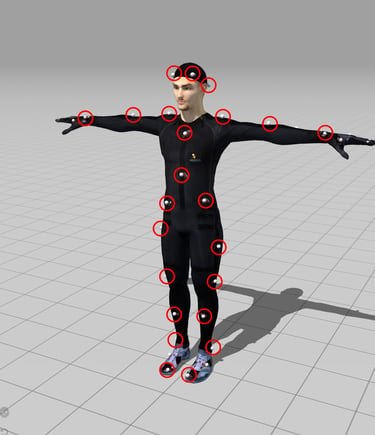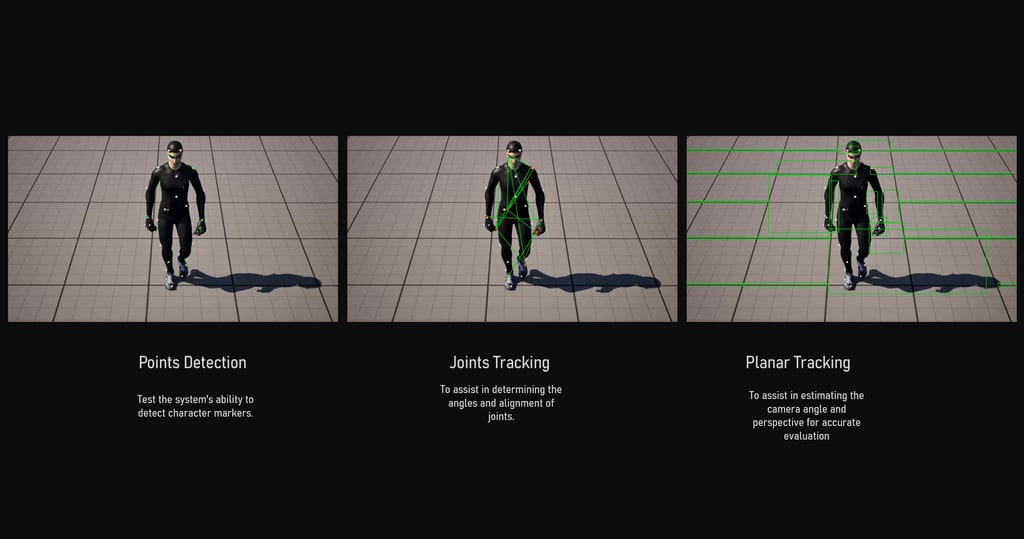Virtual-to-Virtual Motion Capture: A Novel Approach to Animation Analysis


Virtual-to-Virtual Motion Capture: A Novel Approach to Animation Analysi
Introduction to Virtual Motion Analysis
The conventional application of motion capture technology typically involves recording human movements for translation into digital character animation. However, recent methodological innovations introduce an inverse analytical approach: applying motion capture analysis to three-dimensional virtual characters themselves. This creates a virtual-to-virtual analytical framework that represents a significant departure from traditional motion capture applications.
Strategic Marker Placement in Virtual Analysis
The red circular markers visible on the virtual character represent a sophisticated tracking system analogous to physical motion capture markers. These strategically positioned reference points function as the foundation of the analytical framework. The distribution pattern follows biomechanical principles:
Cranial Markers: Multiple markers positioned around the head capture nuanced facial movements and head orientation changes.
Appendicular Markers: Markers along the arms and legs track limb movement through three-dimensional space, with particular concentration at joints.
Axial Markers: Centrally positioned markers on the torso and spine monitor core movement and postural adjustments.
Extremity Markers: Specialized markers on hands and feet capture fine motor movements and ground interaction dynamics.
This marker configuration enables precise tracking of the virtual character's movement components across multiple anatomical landmarks simultaneously. The system records positional data for each marker at defined intervals, generating comprehensive movement datasets for subsequent analysis.
Methodological Innovation
This novel research methodology employs AI-powered motion capture systems to analyze the movement characteristics of virtual characters as though they were physical entities. The approach utilizes standard motion tracking markers applied to a three-dimensional character model (in this case, a Maximo character) within a controlled virtual environment. The virtual markers correspond to anatomical landmarks typically tracked in human subjects.
The innovation lies in treating the virtual character as the primary subject of motion analysis rather than as the recipient of human-derived motion data. This creates a unique recursive analytical framework where animation technology scrutinizes animation output.
Technical Applications
This virtual-to-virtual methodology offers several technical advantages:
Controlled Variable Environment: The virtual environment eliminates numerous variables inherent in physical motion capture sessions, including equipment limitations, environmental factors, and subject inconsistencies.
Perfect Replication Capability: The methodology permits perfect replication of movement sequences, enabling precise comparative analysis impossible with human subjects.
Benchmark Development: Virtual characters can execute idealized movement patterns, establishing theoretical performance benchmarks for motion capture systems.
System Calibration Enhancement: The approach facilitates precise calibration of AI motion capture systems against known virtual movement parameters.
Algorithmic Validation: The methodology enables validation of motion detection algorithms using virtual movements with predefined characteristics.
Research Implications
This approach holds particular significance for:
Animation Quality Assessment: Quantitative evaluation of animation fidelity across different production techniques.
Motion Capture System Validation: Verification of system accuracy using virtual characters with predetermined movement specifications.
AI Training Optimization: Generation of perfectly labeled training datasets for machine learning models in motion recognition.
Cross-System Standardization: Development of standardized virtual movement protocols for comparing different motion capture technologies.
Analytical Applications of Virtual Marker Data
The data collected from these virtual markers enables several sophisticated analytical applications:
Movement Decomposition: The marker system allows decomposition of complex movements into constituent components, enabling precise identification of movement anomalies.
Quantitative Performance Metrics: Marker trajectories provide quantifiable data on movement parameters including velocity, acceleration, positional accuracy, and rotational precision.
Comparative Analysis: The marker system facilitates direct comparison between different animation techniques, character models, or physics engines using standardized movement protocols.
AI Training Enhancement: The perfectly labeled marker positions create ideal training datasets for machine learning algorithms, improving motion recognition capabilities.
Error Detection Systems: Deviations in marker relationships can identify animation inconsistencies, physics calculation errors, or model deformation issues.
A Rare Methodological Approach
This virtual-to-virtual motion capture methodology represents an uncommon approach in animation analysis. Research employing this specific technique—analyzing virtual characters through motion capture systems rather than applying captured human movement to virtual models—appears to be extremely limited or possibly nonexistent in current technical literature.
The novelty lies in its inversion of the traditional workflow, creating a specialized analytical framework for examining technical parameters of both animation systems and motion capture technologies. While not revolutionary, this approach fills a specific analytical gap by treating the virtual character as a subject of motion analysis rather than solely as an output medium.
Conclusion
This methodology demonstrates potential value for AI-based motion capture validation, creating a controlled experimental environment where virtual character movements serve as the analytical baseline. The precision offered by the marker-based analysis system enables quantitative assessment of animation quality and movement fidelity in ways that would be difficult to achieve with human subjects due to inherent variability.
While not completely unprecedented, this approach offers a specialized technical perspective that merits further exploration, particularly as AI-based animation and motion capture technologies continue to advance.

